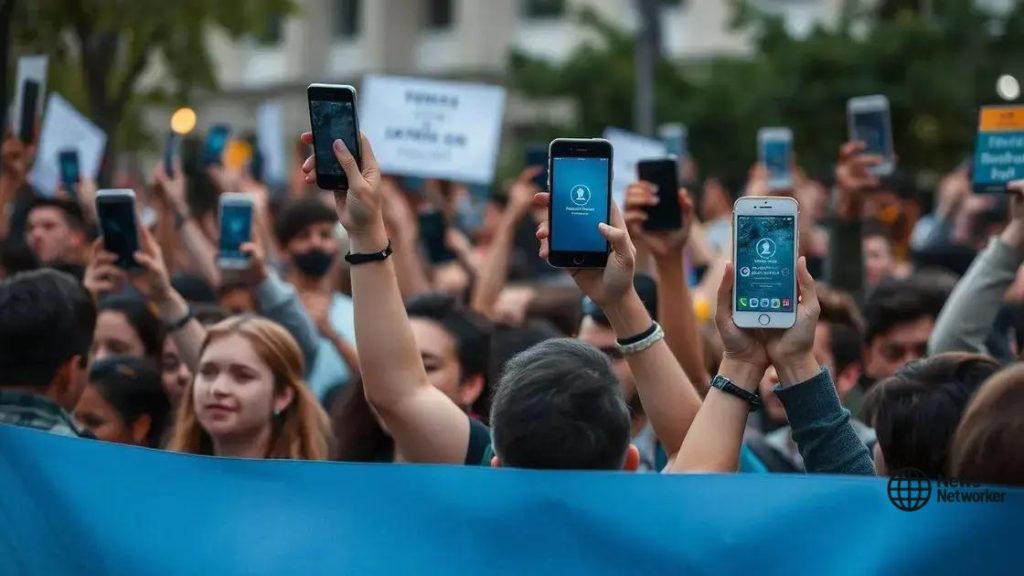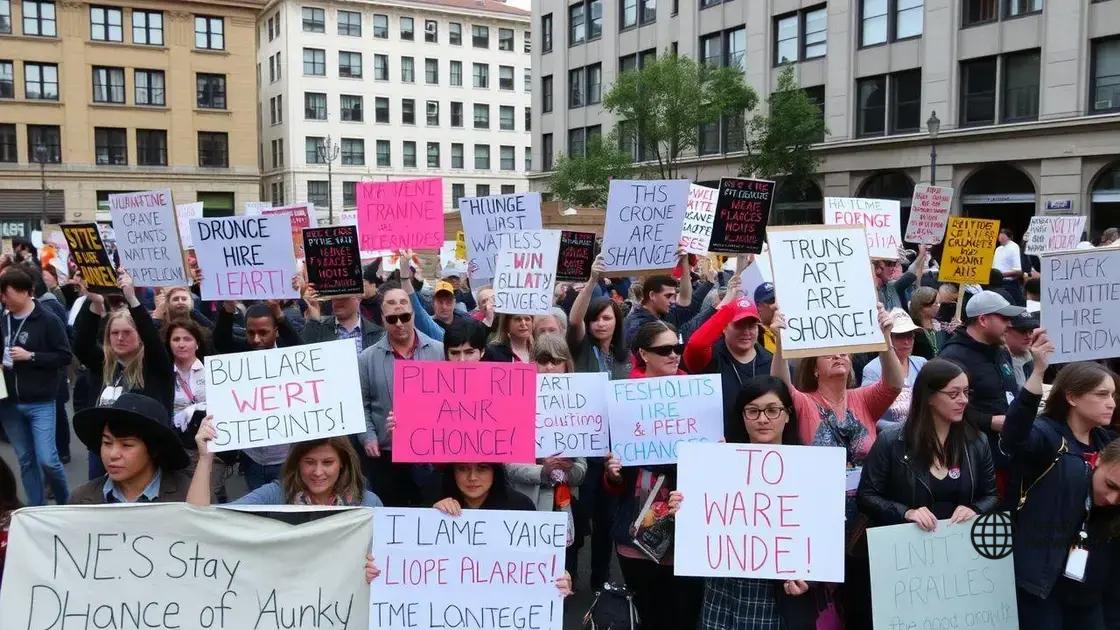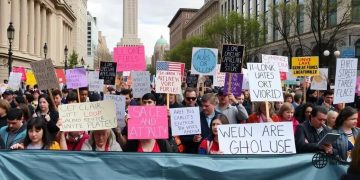Protests triggered by internet access restrictions spread globally

Protests triggered by internet access restrictions demonstrate the vital role of online freedom in enabling communication, mobilization, and social change, highlighting the need for ongoing advocacy against censorship and surveillance.
Protests triggered by internet access restrictions are becoming a significant issue worldwide. As people fight for their right to connect, we see how crucial the internet is in modern society. What happens when that access is cut off?
Understanding internet access restrictions
Understanding internet access restrictions is vital in today’s digital age. These restrictions can take various forms and have wide-ranging effects on society. They often come into play during protests, when governments attempt to control the flow of information. This directly impacts how people communicate and organize.
Types of Internet Access Restrictions
There are several key types of restrictions that you might encounter, including:
- Complete shutdowns: This is when governments completely disconnect the internet in a specific area.
- Content filtering: Here, specific websites or platforms are blocked, limiting access to information.
- Bandwidth throttling: This involves slowing down internet speed for certain services, making them less usable.
- Surveillance: Increased monitoring can create an environment of fear, leading people to restrain their online activities.
Internet access restrictions often arise during sensitive times, like elections or social unrest. When people can’t share information, it hampers their ability to mobilize and express dissent. Communication technologies play a crucial role in organizing protests, and cutting off access can stifle this momentum.
The Impact on Society
These restrictions impact more than just individual rights; they influence democracy and societal progress. For example, when information is stifled, citizens may not understand the full scope of issues affecting their lives. This lack of awareness can lead to public apathy or mistrust in government institutions.
Moreover, in an increasingly digital world, limiting internet access disproportionately affects marginalized communities. Their voices may be silenced, further entrenching existing inequalities and injustice. While some argue that these measures are necessary for national security, the cost to freedom of expression is significant.
Efforts to counter these restrictions have grown, as activists and organizations fight for online freedoms. These can include creating mirror sites, using VPNs, or mobilizing social media campaigns to raise awareness and pressure governments to restore access.
The global impact of internet shutdowns
The global impact of internet shutdowns is profound and far-reaching. When governments impose these restrictions, they don’t just cut off access to social media or news; they hinder the flow of essential information. Communities rely on the internet not only for communication but also for accessing vital services such as education and healthcare.
Economic Consequences
One immediate effect of internet shutdowns is the economic loss experienced by businesses. Small enterprises, in particular, suffer greatly since many rely on online sales and communication. Some key impacts include:
- Loss of revenue: Businesses cannot operate without online access, leading to significant financial losses.
- Disruption of essential services: Companies that provide utilities or critical services may struggle to communicate effectively.
- Job losses: Prolonged shutdowns can lead to layoffs, affecting families and communities.
Additionally, the cost of internet shutdowns can extend to the national economy, impacting overall productivity and growth. Governments may face backlash not only from citizens but also from international businesses concerned about instability.
Social Consequences
On a social level, the consequences of internet shutdowns are equally dire. People lose the ability to connect with loved ones or share their experiences. Social media becomes critical during protests and shutdowns, offering a platform for voices that might otherwise be silenced. Without this communication tool, communities find it harder to organize and advocate for their rights.
During shutdowns, misinformation can spread easily since people cannot verify facts or share credible sources. This lack of reliable information can lead to confusion and fear within communities. When connectivity is regained, the fallout from the disinformation can be challenging to rectify.
Furthermore, the emotional toll on individuals can be significant. Many feel isolated and powerless, unsure of what is happening in their country. This leads to diminished trust in authorities, as citizens may perceive the shutdowns as a tactic to control dissent.
How protests spark change

Protests have the power to spark change in society by raising awareness and mobilizing communities. When a large group of individuals come together to voice their concerns, it often leads to a shift in public opinion. This collective action serves as a catalyst for dialogue and reform.
Historical Examples of Change
Many notable protests throughout history have resulted in significant change. These events highlight the importance of collective action. Some key protests include:
- The Civil Rights Movement: This movement fought for racial equality in the United States and led to critical legislation such as the Civil Rights Act.
- The Women’s Suffrage Movement: Women organized protests to demand the right to vote, ultimately leading to the passage of the 19th Amendment.
- The Anti-Apartheid Movement: Protesters worldwide rallied against apartheid in South Africa, contributing to the end of institutionalized racial segregation.
These examples illustrate that when people unite for a common cause, they can influence policymakers and inspire others to join their fight. Grassroots movements often begin with local protests that highlight specific issues, gradually gaining traction and media attention.
The Role of Social Media
In today’s digital age, social media plays a crucial role in organizing protests. Activists can spread their messages quickly and to vast audiences. Platforms like Twitter, Instagram, and Facebook allow protest organizers to:
- Share updates and important information in real-time.
- Recruit participants and gain support from outside the immediate community.
- Document the events and share stories that resonate with a broader audience.
Social media amplifies the voices of those protesting and can compel policymakers to respond. It also helps to keep global audiences informed about local struggles, fostering international solidarity.
Moreover, protests can lead to legislative changes when they attract enough attention. Policymakers often feel pressured to react to public sentiment, particularly if protests receive media coverage. This influence is seen in how politicians may shift their positions or propose new laws in direct response to the demands being made.
Case studies of major protests
Case studies of major protests reveal how ordinary people can instigate significant change. These events often serve as powerful reminders of the strength of collective action. By examining key protests, we see how they have shaped policies and society.
The Arab Spring
The Arab Spring was a series of protests across the Middle East and North Africa beginning in late 2010. It was driven by dissatisfaction with authoritarian regimes and economic instability. Some important outcomes include:
- Overthrow of long-standing leaders in countries like Tunisia, Egypt, and Libya.
- Increased calls for democracy and human rights across the region.
- Significant social media use that mobilized support and spread awareness of issues.
This movement highlighted the power of youth in leading change while also showing that the aftermath can be complex and sometimes result in continued conflict.
The Black Lives Matter Movement
The Black Lives Matter movement began in 2013 and gained considerable momentum following the death of George Floyd in 2020. It underscores ongoing issues of racial inequality and police brutality in the United States. Noteworthy aspects include:
- Massive protests across the U.S. and the world advocating for justice and systemic change.
- Influence on policy changes, including calls to reform police practices.
- The creation of a global dialogue on racism and social justice.
This movement has brought issues of race and justice to the forefront of public discourse, fostering a greater awareness of systemic inequalities.
The Women’s March
The Women’s March took place in January 2017 as a reaction to the election of Donald Trump. It focused on women’s rights and equality issues. Key elements of this protest include:
- Participation of millions of people globally, showing solidarity for women’s rights.
- Advocacy for key issues such as reproductive rights and equal pay.
- Persistent activism that has led to increased engagement in politics, especially among women.
The Women’s March exemplifies the ability of organized movements to inspire action and encourage participation in the political process.
Future implications for online freedom
The future implications for online freedom are crucial as societies continue to grapple with the impact of internet access and restrictions. As digital landscapes evolve, many anticipate significant changes in how individuals communicate, organize protests, and express their viewpoints online.
Increased Surveillance
One major concern is the rise of surveillance technology. Governments are increasingly using these tools to monitor citizens. This could lead to:
- A chilling effect on free speech, as people may fear being watched.
- The potential for misuse of personal data, leading to privacy violations.
- Increased censorship of dissenting opinions, further undermining online freedom.
As people strive to maintain their rights, understanding the balance between security and privacy will be essential.
Technological Advances
Technological advancements may also shape future online freedom. New tools and platforms allow for greater accessibility, but they can also pose challenges. For instance:
- Decentralized platforms could provide alternatives to traditional social media, enhancing users’ control.
- Blockchain technology may offer solutions for privacy and securing data.
- AI can help identify and combat misinformation, but it also raises concerns about bias and control.
These developments all have the power to influence how society views and utilizes online spaces.
Global Collaboration
International collaboration will be vital in promoting and protecting online freedom. Countries must work together to establish guidelines that prioritize human rights over censorship. This could involve:
- Creating global agreements to protect citizens’ digital rights.
- Encouraging awareness and education about online privacy and security.
- Strengthening networks among activists and organizations focused on online freedoms.
As the global community continues to address challenges related to internet access, these collaborative efforts will be instrumental in safeguarding the rights of users.
FAQ – Questions about Online Freedom and Protests
What are some common causes of internet shutdowns?
Internet shutdowns often occur during political unrest, protests, or to control the flow of information during sensitive events.
How do protests impact online freedom?
Protests can raise awareness about the importance of online freedom and lead to calls for policy changes that protect citizens’ digital rights.
Why is surveillance on the rise during protests?
Governments may increase surveillance in response to protests to monitor activities and control dissent, which can infringe on privacy rights.
How can technology help protect online freedoms?
New technologies, such as encryption and decentralized platforms, can help users maintain privacy and prevent unauthorized access to their information.





